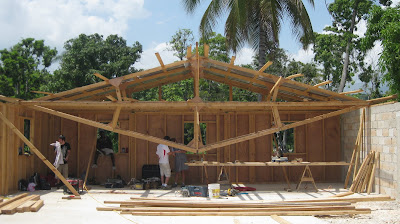About halfway through the trip, a group of us were able to take an hour and a half walk off the main road and into one of the smaller villages. It was a more intimate look into the daily lives of some of the Haitian people.
We first met a mother and her children outside doing laundry. She was very welcoming and even let us look inside her home and take pictures.
Both beds touched each wall... one room...
As we continued on our walk, I was amazed by the beautiful scenery and green vegetation. Haiti comes from Ayiti which means "Land of high mountains" in the language of the indigenous people of the Hispaniola Island.
It seemed as if every family we came across was outside doing laundry.
We then met a mother who showed us her home after the earthquake. She said she was in the house with her children when the earthquake hit, and now her house is in ruins. She stated that an organization came and built a new home, however the roof and sides began to leak, so she is staying with family until she can figure out what to do.
This was the home that was built for her, but leaks....
We then walked into this beautiful countryside. We were told that there was a grant in process to help teach sustainable farming techniques.
It was such an amazing opportunity to see this intimate side of Haiti and to hear the stories of the earthquake survivors. It was also interesting that most of the women we met along the walk were single mothers raising their children on their own.
I found this article from NPR from November 2010 (10 months after the earthquake) and I think it does a good job articulating what some of the living conditions are like for many people in Haiti.




































